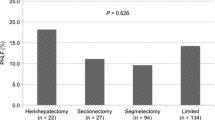Abstract
Background
The Model for End-Stage Liver Disease (MELD) score is currently used as a disease severity index of cirrhotic patients awaiting liver transplantation. This study evaluated the usefulness of the MELD score in predicting mortality and morbidity of patients with hepatocellular carcinoma (HCC) undergoing hepatic resection.
Methods
The study cohort consisted of 1,017 patients who underwent hepatic resection for HCC between 1991 and 2005. Patient variables were examined by univariate and multivariate analyses to identify risk factors for morbidity and mortality. Accuracy in predicting mortality was assessed with the area under the receiver operator characteristic curve (AUC) analysis.
Results
The morbidity and mortality rates were 30.7% and 1.9%, respectively. Age, liver cirrhosis, operation time, and MELD score were risk factors for mortality, whereas indocyanine green retention rate at 15-min value, operation time, blood loss, and Child-Turcotte-Pugh score were risk factors for morbidity. Patients with MELD score >8 had higher mortality (4.0% vs. 0.6%, p = 0.004) and higher liver-related morbidities (16.1% vs. 4.3%, p < 0.001), including massive ascites, intra-abdominal hemorrhage, and hepatic failure, compared with patients with MELD score <6. High MELD score also was related to longer postoperative hospital stay (score >8, 14.5 days vs. score <6, 12.6 days, p = 0.015). The AUC for MELD score as a predictor of mortality was 0.718, indicating high clinical usefulness.
Conclusions
The MELD score relates with mortality and liver-related morbidities in HCC patients who undergo hepatic resection. A MELD sore >8 represents the trigger for intensive treatment to improve patient outcome.


Similar content being viewed by others
References
Llovet JM, Burroughs A, Bruix J (2003) Hepatocellular carcinoma. Lancet 362:1907–1917
Chang CH, Chau GY, Lui WY et al (2004) Long-term results of hepatic resection for hepatocellular carcinoma originating from the noncirrhotic liver. Arch Surg 139:320–325
Capussotti L, Muratore A, Amisano R et al (2005) Liver resection for hepatocellular carcinoma on cirrhosis: analysis of mortality, morbidity and survival- a European single center experience. Eur J Surg Oncol 31:986–993
Belghiti J, Regimbeau JM, Durand F et al (2002) Resection of hepatocellular carcinoma: a European experience on 328 cases. Hepatogastroenterology 49:41–46
Malinchoc M, Kamath PS, Gordon FD et al (2000) A model to predict poor survival in patients undergoing transjugular intrahepatic portosystemic shunts. Hepatology 31:864–871
Kamath PS, Wiesner RH, Malinchoc M et al (2001) A model to predict survival in patients with end-stage liver disease. Hepatology 33:464–470
Freeman RB, Wiesner RH, Harper A et al (2002) The new liver allocation system: moving toward evidence-based transplantation policy. Liver Transpl 8:851–858
Teh SH, Christein J, Donohue J et al (2005) Hepatic resection of hepatocellular carcinoma in patients with cirrhosis: model of end-stage liver disease (MELD) score predicts perioperative mortality. J Gastrointest Surg 9:1207–1215
Cucchetti A, Ercolani G, Vivarelli M et al (2006) Impact of model for end-stage liver disease (MELD) score on prognosis after hepatectomy for hepatocellular carcinoma on cirrhosis. Liver Transpl 12:966–971
Cucchetti A, Ercolani G, Cescon M et al (2006) Recovery from liver failure after hepatectomy for hepatocellular carcinoma in cirrhosis: meaning of the model for end-stage liver disease. J Am Coll Surg 203:670–676
Schroeder RA, Marroquin CE, Bute BP et al (2006) Predictive indices of morbidity and mortality after liver resection. Ann Surg 243:373–379
Lui WY, Chau GY, Loong CC et al (1995) Hepatic segmentectomy for curative resection of primary hepatocellular carcinoma. Arch Surg 130:1090–1097
Lui WY, Chau GY (1997) Operative approaches to hepatocellular carcinoma in the cirrhotic patient. In: Wanebo HJ (ed) Surgery for gastrointestinal cancer: a multidisciplinary approach. Lippincott-Raven, Philadelphia, pp 533–539
Chau GY, Lui WY, King KL et al (2005) Evaluation of effect of hemihepatic vascular occlusion and the Pringle maneuver during hepatic resection for patients with hepatocellular carcinoma and impaired liver function. World J Surg 29:1374–1383
Greene FL, Page DL, Fleming ID et al (eds) (2002) Liver including intrahepatic bile ducts. American Joint Committee on cancer staging manual, 6th edn. Springer, New York, pp 131–144
Pugh RNH, Murray-Lyon IM, Dawson JL et al (1973) Transection of the esophagus in bleeding esophageal varices. Br J Surg 60:648–652
Hemming AW, Scudamore CH, Shackleton CR et al (1992) Indocyanine green clearance as a predictor of successful hepatic resection in cirrhotic patients. Am J Surg 163:515–518
Balzan S, Belghiti J, Farges O, Ogata S et al (2005) The “50–50 criteria” on postoperative day 5 an accurate predictor of liver failure and death after hepatectomy. Ann Surg 242:824–829
Wu CC, Yeh DC, Lin MC et al (2001) Improving operative safety for cirrhotic liver resection. Br J Surg 88:210–215
Fan ST, Lai ECS, Lo CM et al (1995) Hospital mortality of major hepatectomy for hepatocellular carcinoma associated with cirrhosis. Arch Surg 130:198–203
Wei AC, Poon RTP, Fan ST et al (2003) Risk factors for perioperative morbidity and mortality after extended hepatectomy for hepatocellular carcinoma. Br J Surg 90:33–41
Oellerich M, Burdelski M, Lauta HU et al (1991) Assessment of pretransplant prognosis in patients with cirrhosis. Transplantation 51:801–806
Testa R, Valente U, Risso D et al (1999) Can the MEGX test and serum bile acids improve the prognostic ability of Child-Pugh’s score in liver cirrhosis? Eur J Gastroenterol Hepatol 11:559–563
Shrestha R, McKinley C, Showalter R et al (1997) Quantitative liver function tests define the functional severity of liver disease in early-stage cirrhosis. Liver Transpl Surg 3:166–173
Kamath PS, Kim WR, Advanced Liver Disease Study Group (2007) The model for end-stage liver disease (MELD). Hepatology 45:797–805
Imamura H, Seyama Y, Kokudo N et al (2003) One thousand fifty-six hepatectomies without mortality in 8 years. Arch Surg 138:1198–1206
Author information
Authors and Affiliations
Corresponding author
Rights and permissions
About this article
Cite this article
Hsu, KY., Chau, GY., Lui, WY. et al. Predicting Morbidity and Mortality After Hepatic Resection in Patients with Hepatocellular Carcinoma: The Role of Model for End-Stage Liver Disease Score. World J Surg 33, 2412–2419 (2009). https://doi.org/10.1007/s00268-009-0202-4
Published:
Issue Date:
DOI: https://doi.org/10.1007/s00268-009-0202-4




